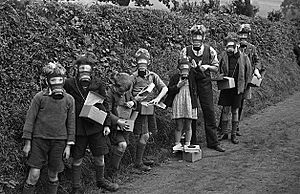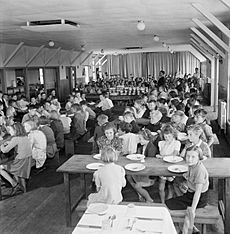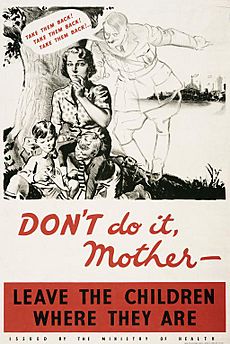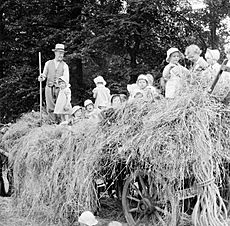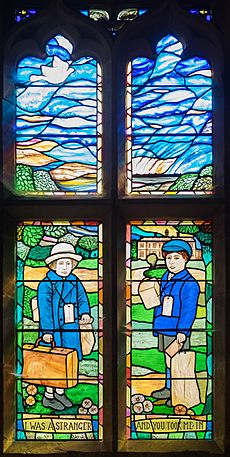Evacuations of civilians in Britain during World War II facts for kids
The evacuation of civilians in Britain during the Second World War was a big plan to keep people safe. It especially aimed to protect children from the dangers of bombing raids by moving them to safer areas.
This huge effort was called "Operation Pied Piper". It started on 1 September 1939 and officially moved 1.5 million people. More official evacuations happened in June 1940 from the south and east coasts when a sea invasion was feared. After the Blitz (heavy bombing) began in September 1940, people were also moved from bombed cities. Some people even left the UK for other parts of the British Empire. Many others moved on their own. British citizens also arrived from the Channel Islands, and displaced people came from Europe.
Contents
Why Evacuate?
The government created the Evacuation Scheme in 1938. It was managed by the Ministry of Health. The country was split into three types of areas: "evacuation" (cities at risk), "neutral" (not much risk), and "reception" (safer rural areas). Children and other priority groups were moved from big cities to private homes in the countryside.
In early 1939, the reception areas listed all the homes that could take evacuees. There was space for about 2 million people. The government also built some camps for a few thousand more.
The government told people about the plan in summer 1939. They thought 80% of school children would move, but only about half actually did. In some cities, only 15% of children left, while in places like Manchester, Belfast, and Liverpool, over 60% were evacuated. In the end, over 3 million people were moved.
The Evacuation Begins
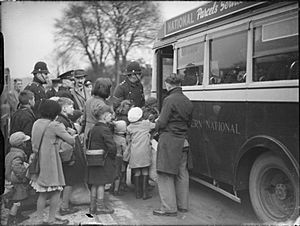
Almost 3.75 million people were displaced, meaning they had to leave their homes. About a third of everyone in Britain was affected by the evacuation in some way. In the first three days of the official evacuation, 1.5 million people moved. This included 827,000 school children, 524,000 mothers with young children, 13,000 pregnant women, 70,000 disabled people, and over 103,000 teachers and helpers. Children were often separated from their parents.
Not just people were moved. Important things and organizations also left the cities. For example, the National Gallery's art collection was sent to a quarry in North Wales. The Bank of England moved its gold to Canada! The BBC moved some of its shows and staff to safer towns. Many Post Office staff also moved. Some private companies moved their main offices or important records away from big cities.
Even parts of the government were evacuated. Under "Plan Yellow," about 23,000 government workers and their papers went to hotels in seaside towns. There was also a secret "Black Move" plan in case London was destroyed. Under this plan, the government would move to the West Midlands. The War Cabinet and ministers would go to places near Worcester, and Parliament would meet in Stratford-upon-Avon. King George VI and the royal family would stay at Madresfield Court.
Some areas that took in many children used "double shift education." This meant schools taught twice as many students by having one group in the morning and another in the afternoon. This took longer but helped more children. However, many children who stayed home had no schooling because their teachers had moved.
Evacuation Camps
In 1939, the British Government passed a law to create the National Camps Corporation. This group built special camps for young people. These camps were for outdoor learning and could also be used as evacuation centers during the war. An architect named T. S. Tait designed the buildings. Each camp could hold over 200 children and staff, with halls, washrooms, and a dining area. Over thirty of these camps were built in rural areas.
During the war, these camps were safe places for city children. After the war, local councils took over the sites. Most of these camps are gone now, but Sayers Croft in Ewhurst, Surrey is a good example that is still preserved. Its dining hall is a protected building because of Tait's work and the murals painted inside that show the life of evacuees. Other Evacuation Centres were also set up by the Foster Parent Plan (FPP), which later became Plan International.
One school that was evacuated to Knutsford, Cheshire, was sponsored by the FPP. Each child there was supported by an American citizen. For example, a girl named Paulette was sponsored by Mrs. Eleanor Roosevelt, the wife of the US President.
Moving Overseas
The Children's Overseas Reception Board (CORB) planned to send 24,000 children overseas. Between June and September 1940, 1,532 children went to Canada, 577 to Australia, 353 to South Africa, and 202 to New Zealand. However, this plan was stopped after the ship City of Benares was sunk on 17 September 1940. Sadly, 77 of the 90 CORB children on board died. Even so, about 14,000 children were privately evacuated overseas in 1940 and 1941, often to relatives or foster families. This included 6,000 to Canada and 5,000 to the United States.
The BBC worked with radio stations in other countries to create a show called Children Calling Home. This program allowed evacuated children and their parents to talk to each other live on the radio.
Other Evacuations
A second big evacuation happened after France fell in June 1940. From 13 to 18 June 1940, about 100,000 children were moved again. People who were vulnerable were moved from coastal towns in southern and eastern England because they faced German-controlled areas. By July, over 200,000 children had been moved. Some towns in Kent and East Anglia evacuated over 40% of their people. Also, about 30,000 people arrived from Europe, and 25,000 came from the Channel Islands.
Thousands of school children from Guernsey arrived in northern England with their teachers. Some were allowed to restart their schools in empty buildings. Guernsey's Forest School reopened in a church hall in Cheadle Hulme, Cheshire, and stayed there until August 1945. Because so many Guernsey people were evacuated to England, many who returned after the war no longer spoke their local language, Guernsiaise.
When the Blitz (heavy bombing of British cities) started in September 1940, it was clear that evacuation was needed. People who made their own arrangements to move were given free travel and money for lodging. This was also offered to children, the elderly, disabled people, pregnant women, the sick, and those who had lost their homes. London's population dropped by almost 25% due to all these efforts.
As bombing spread to more towns, "assisted private evacuation" was expanded. However, not all evacuated children, mothers, and teachers were completely safe in their new areas. Air raids, unexploded bombs, and military vehicles still posed risks.
London was strong against the bombing, but smaller towns often saw more panic and people leaving on their own. The number of official evacuees reached 1.37 million by February 1941. By September, it was just over one million. By the end of 1943, only 350,000 people were officially housed. However, when V-1 flying bombs started attacking London in June 1944, another 1.5 million people left by September. Only 20% of these were "official" evacuees.
From September 1944, the evacuation process was officially stopped and reversed for most areas, except London and the east coast. Returning to London was not officially allowed until June 1945. In March 1946, the housing scheme ended, with 38,000 people still without homes.
Impact on Children
Even at the time, some people worried about the emotional effect on younger children. They wondered if it was better for them to stay with their parents, even with the risks.
In the early 2000s, some former evacuees shared their stories, highlighting the "bad sides" of being evacuated.
Evacuation in Books and Movies
The experience of city children moving to new rural places without their parents had a huge impact. The Evacuees Reunion Association was created to help former evacuees share their stories. It also helps researchers learn about the long-term effects of evacuation on children.
The evacuation inspired many children's and young adult books. The setting was perfect for writers, letting child heroes have adventures in a strange, new world. Some authors, like Nina Bawden, were evacuees themselves.
Here are some famous books and movies about evacuees:
- Visitors from London (1940) by Kitty Barne is an early novel about evacuees in Sussex.
- In C. S. Lewis's The Lion, the Witch, and the Wardrobe (1950), the Pevensie children are evacuated from London to a big house with a magical wardrobe.
- William Golding's Lord of the Flies (1954) is about a plane full of evacuating children who crash on a tropical island.
- Michael Bond's character Paddington Bear (1958) was inspired by newsreels of child evacuees leaving London with labels and small suitcases. Paddington is an orphan bear found at Paddington railway station with a note asking someone to look after him.
- Nina Bawden's Carrie's War (1973) tells the story of Carrie and Nick, who learn about different religions when they are evacuated to Wales.
- Michelle Magorian's Goodnight Mister Tom (1981) is about an evacuee named Willie Beech and the kind old man, Thomas Oakley, who takes him in. It was made into a TV film.
- In the Disney movie Return to Never Land, Wendy Darling's children, Jane and Daniel, are preparing for evacuation before Jane is taken by Captain Hook.
- The 1971 movie Bedknobs and Broomsticks shows evacuated children being taken in by a good witch-in-training.
- The 2014 movie The Woman in Black 2: Angel of Death features a headmistress and teacher evacuating children from London.
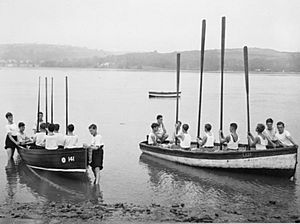
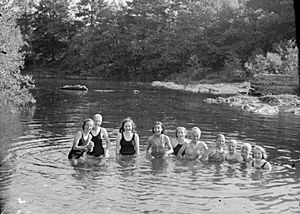
See also



